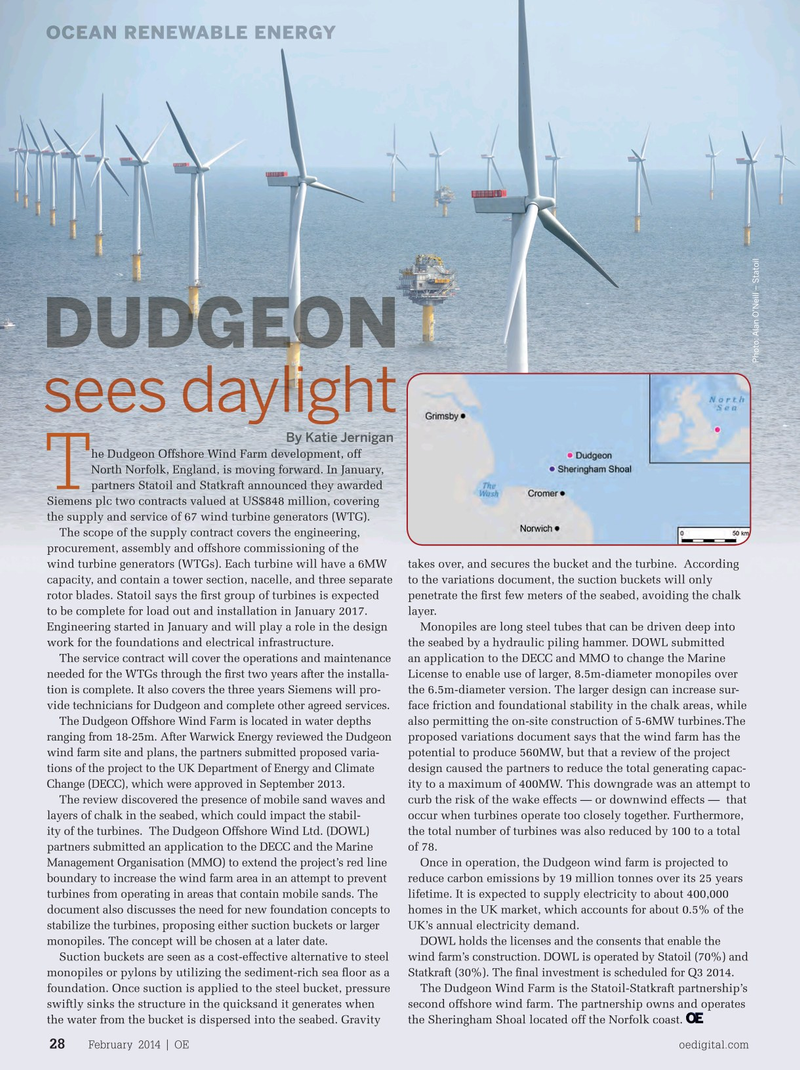
Page 26: of Offshore Engineer Magazine (Feb/Mar 2014)
Read this page in Pdf, Flash or Html5 edition of Feb/Mar 2014 Offshore Engineer Magazine
OCEAN RENEWABLE ENERGY
DUDGEON
Photo: Alan O’Neill – Statoil sees daylight
By Katie Jernigan he Dudgeon Offshore Wind Farm development, off
North Norfolk, England, is moving forward. In January,
T partners Statoil and Statkraft announced they awarded
Siemens plc two contracts valued at US$848 million, covering the supply and service of 67 wind turbine generators (WTG).
The scope of the supply contract covers the engineering, procurement, assembly and offshore commissioning of the wind turbine generators (WTGs). Each turbine will have a 6MW takes over, and secures the bucket and the turbine. According capacity, and contain a tower section, nacelle, and three separate to the variations document, the suction buckets will only rotor blades. Statoil says the ? rst group of turbines is expected penetrate the ? rst few meters of the seabed, avoiding the chalk to be complete for load out and installation in January 2017. layer.
Engineering started in January and will play a role in the design Monopiles are long steel tubes that can be driven deep into work for the foundations and electrical infrastructure. the seabed by a hydraulic piling hammer. DOWL submitted
The service contract will cover the operations and maintenance an application to the DECC and MMO to change the Marine needed for the WTGs through the ? rst two years after the installa- License to enable use of larger, 8.5m-diameter monopiles over tion is complete. It also covers the three years Siemens will pro- the 6.5m-diameter version. The larger design can increase sur- vide technicians for Dudgeon and complete other agreed services. face friction and foundational stability in the chalk areas, while
The Dudgeon Offshore Wind Farm is located in water depths also permitting the on-site construction of 5-6MW turbines.The ranging from 18-25m. After Warwick Energy reviewed the Dudgeon proposed variations document says that the wind farm has the wind farm site and plans, the partners submitted proposed varia- potential to produce 560MW, but that a review of the project tions of the project to the UK Department of Energy and Climate design caused the partners to reduce the total generating capac-
Change (DECC), which were approved in September 2013.
ity to a maximum of 400MW. This downgrade was an attempt to
The review discovered the presence of mobile sand waves and curb the risk of the wake effects — or downwind effects — that layers of chalk in the seabed, which could impact the stabil- occur when turbines operate too closely together. Furthermore, ity of the turbines. The Dudgeon Offshore Wind Ltd. (DOWL) the total number of turbines was also reduced by 100 to a total partners submitted an application to the DECC and the Marine of 78.
Management Organisation (MMO) to extend the project’s red line Once in operation, the Dudgeon wind farm is projected to boundary to increase the wind farm area in an attempt to prevent reduce carbon emissions by 19 million tonnes over its 25 years turbines from operating in areas that contain mobile sands. The lifetime. It is expected to supply electricity to about 400,000 document also discusses the need for new foundation concepts to homes in the UK market, which accounts for about 0.5% of the stabilize the turbines, proposing either suction buckets or larger UK’s annual electricity demand.
DOWL holds the licenses and the consents that enable the monopiles. The concept will be chosen at a later date. wind farm’s construction. DOWL is operated by Statoil (70%) and
Suction buckets are seen as a cost-effective alternative to steel
Statkraft (30%). The ? nal investment is scheduled for Q3 2014. monopiles or pylons by utilizing the sediment-rich sea ? oor as a foundation. Once suction is applied to the steel bucket, pressure The Dudgeon Wind Farm is the Statoil-Statkraft partnership’s swiftly sinks the structure in the quicksand it generates when second offshore wind farm. The partnership owns and operates the water from the bucket is dispersed into the seabed. Gravity the Sheringham Shoal located off the Norfolk coast.
February 2014 | OE oedigital.com 28 028-OE0214_ Cover4_Dudgeon.indd 28 1/21/14 3:58 PM

 25
25

 27
27